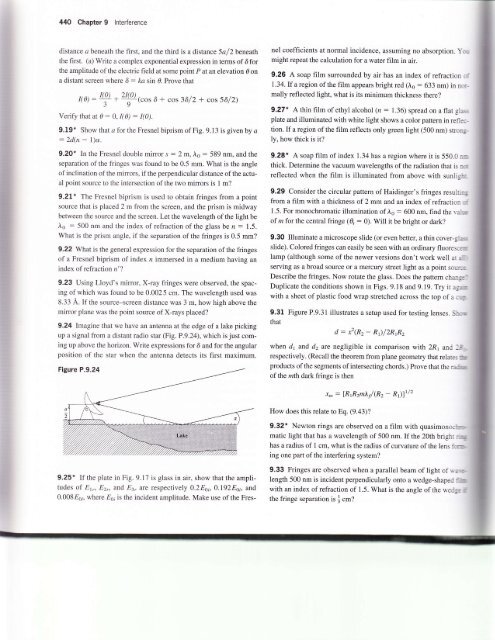' \^' I
' \^' I
' \^' I
Create successful ePaper yourself
Turn your PDF publications into a flip-book with our unique Google optimized e-Paper software.
440 Chapter 9 lnterference<br />
distance a beneath the first, and the third is a distance 5af2beneath<br />
the first. (a) Write a complex exponential expression in terms of 6 for<br />
the amplitude of the electric field at some point P at an elevation 0 on<br />
a distant screen where 6 : ka sin 0. Prove that<br />
t(0) - I(!) + {Qtcos 6 -F cos 36/2 + cos 56121<br />
39<br />
Verify that at 0 : 0, I(0) : 40).<br />
9. 1 9* Show lhat a for the Fresnel biprism of Fig. 9. 1 3 is given by a<br />
:2d(.n<br />
- 1)a.<br />
9.20* In the Fresnel double mirror s : 2 m, tro = 589 nm, and the<br />
separation of the fringes was found to be 0.5 mm. What is the angle<br />
of inclination of the minors, if the perpendicular distance of the actual<br />
point source to the intersection of the two mirrors is 1 m?<br />
9.21* The Fresnel biprism is used to obtain fringes from a point<br />
source that is placed 2 m from the screen, and the prism is midway<br />
between the source and the screen. Let the wavelength of the light be<br />
tro : 500 nm and the index of refraction of the glass be n : 7.5.<br />
What is the prism angle, if the separation of the fringes is 0.5 mm?<br />
9.22 What is the general expression for the separation of the fringes<br />
of a Fresnel biprism of index n immersed in a medium having an<br />
index of refraction n'7<br />
9.23 Using Lloyd's miror, X-ray fringes were observed, the spacing<br />
of which was found to be 0.002 5 cm. The wavelength used was<br />
8.33 A. If the source-screen distance was 3 m, how high above the<br />
mirror plane was the point source of X-rays placed?<br />
9.24 Imagine that we have an antenna at the edge of a lake picking<br />
up a signal from a distant radio star (Fig. P.9.24), which is just coming<br />
up above the horizon. Write expressions for 6 and for the angular<br />
position of the star when the antenna detects its first maximum.<br />
0.008,E0,, where E6; is the incident amplitude. Make use of the Fresnel<br />
coefficients at normal incidence, assuming no absorption. yor<br />
might repeat the calculation for a water film in air.<br />
9.26 A soap film surrounded by air has an index of refraction oi<br />
1.34.If a region of the film appears bright red (Io = 633 nm) in ncnmally<br />
reflected light, what is its minimum thickness there?<br />
9.27* A thin film ofethyl alcohol (n: 1.36) spread on a flat glasr<br />
plate and illuminated with white light shows a color pattern in reflection.<br />
If a region of the film reflects only green light (500 nm) strongly,<br />
how thick is it?<br />
9.28* A soap film of index 1.34 has a region where it is 550.0 rm<br />
thick. Determine the vacuum wavelengths of the radiation that is nrn<br />
reflected when the film is illuminated from above with sunligfu"<br />
9,29 Consider the circular pattern of Haidinger's fringes resultirg<br />
from a film with a thickness of 2 mm and an index of refraction id<br />
1.5. For monochromatic illumination of I0 : 600 nm, find the valm<br />
of m for the central fringe (Q : 0). Will it be bright or dark?<br />
9.30 Illuminate a microscope slide (or even better, a thin cover-gl*m<br />
slide). Colored fringes can easily be seen with an ordinary fluorescff<br />
lamp (although some of the newer versions don't work well at arll<br />
serving as a broad source or a mercury street light as a point sor-ue<br />
Describe the fringes. Now rotate the glass. Does the pattern chanerT'<br />
Duplicate the conditions shown in Figs. 9.18 and 9.19. Try it agamr<br />
with a sheet of plastic food wrap stretched across the top of a crry,<br />
9.31 Figure P.9.31<br />
that<br />
illustrates a setup used for testing lenses. Shcnn<br />
d = f(R2- R)/2R1R2<br />
when d1 and d2 are negligible in comparison with 2R1 and '"t3.<br />
respectively. (Recall the theorem from plane geometry that relates frc<br />
products of the segments of intersecting chords.) Prove that the raarun;<br />
of the mth dark fringe is then<br />
x*: [R1R2m\f (Rr- Rr)]t/t<br />
How does this relate to Eq. (9.43)?<br />
9.32* Newton rings are observed on a film with quasimonochrmnmatic<br />
light that has a wavelength of 500 nm. If the 20th bright ry<br />
has a radius of I cm, what is the radius of curvature of the lens t-ccmF<br />
ing one part of the interfering system?<br />
9.25* If the plate in Fig. f . i7 is glass in air, show that the amplitudes<br />
of Etn Er,, and E3, are respectively 0.2Eo1, 0.192Esi, and<br />
9.33 Fringes are observed when a parallel beam of light of u-aqe.<br />
length 500 nm is incident perpendicularly onto a wedge-shaped iiftm<br />
with an index of refraction of 1.5. What is the angle of the wedse rS<br />
the fringe separation is I cm?
















